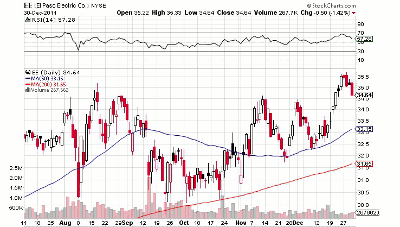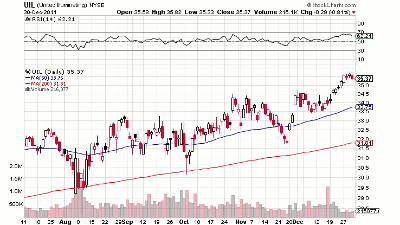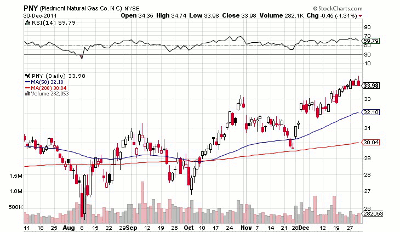The S&P 600, like its benchmark-index sibling, ended 2011 with a very small loss—essentially flat. But as with all indices, some sectors and stocks outperformed the pack. This week, MoneyShow.com contributor Kate Stalter goes over some top names from the best small-cap sector.
The top-performing sector from the S&P SmallCap 600 in 2011 was utilities—not particularly surprising, given that investors were seeking yield, as well as putting money into reliable defensive names.
With Europe likely to roil markets for the foreseeable future, and investors continuing to fret about the economy, defensives and dividend payers should remain in favor as 2012 trading gets under way this week.
One top technical performer heading into the new year is El Paso Electric (EE), which provides service to customers in Texas and New Mexico. The stock rose more than 25% in 2011, and ended the year just below its 16-year high of $35.71.
It was perched just at its ten-day moving average, but struggled to make any traction out of its most recent consolidation. The stock has run higher without undercutting prior lows since mid-2010, and could be ready to take a breather soon.
El Paso Electric’s dividend yield is 2.5%, so it’s been good to investors who sought both price appreciation and yield. A growing number of institutions have bought into the stock in the past year.
One blemish is in the estimates: Analysts expect per-share income of $2.42 this year, down 2% from the $2.47 expected this year. The company reports its fourth-quarter results for 2011 in February.
Another top-performing small-cap utility stock is UIL Holding (UIL), a Connecticut-based electricity provider. The stock has a market cap of around $1.8 billion, and it trades around 406,000 shares per day.
UIL rose 18% in 2011, closing at $35.37 on Friday. It’s been trading at its best levels since September, 2008, and notched three months in a row of upside trade.
The stock’s dividend yield is 4.9%, a factor lending to its appeal.
Analysts see the company wrapping up 2011 with income of $1.96 per share, a gain of 9% over 2010. This year, Wall Street has pegged earnings growth at 12, to $2.19 per share.
Technically, the stock rallied to that three-year high on Friday, but reversed lower the same day. It’s holding well above short-term moving averages as the first trading week of 2012 gets under way.
|pagebreak|Natural gas distributor New Jersey Resources (NJR) climbed 14% in 2011. Its price action on Friday echoed that of UIL. The stock rose to an all-time high intraday, then reversed to close with a loss for the session. It, too, is holding well above key moving averages.
The volatile market action in the summer and fall of 2010 was constructive for the stock, dragging its price below the previous consolidation’s trough. That type of action in a stock often flushes out weak holders, and clears the path for investors seeking a value to step in and buy shares.
That’s exactly what happened with New Jersey Resources, as the stock finished October with a gain of 10.5%, rose 0.6% in November, and 4% last month.
Its dividend yield is 3.1%. Earnings are seen growing 9% this year and 3% in 2013. The first fiscal quarter of 2012 ended in December, with the company expected to report early next month.
I generally look for names with an outstanding combination of fundamental and technical strength, but in recent months, the market has rewarded many traders who capitalized on technicals alone.
One utility name that’s shown tremendous price strength recently, despite some shaky earnings growth, is Piedmont Natural Gas (PNY). The stock ran up more than 21% in 2011, and ended the year getting support right at its ten-day moving average.
Like some of its fellow small-cap utilities, Piedmont rallied to a new high Friday, then reversed to finish the day on the down side.
Its Friday intraday peak of $34.74 marked a three-and-a-half year high. As with most stocks, it traded in lower-than-normal volume in late December.
Piedmont, too, fell into a bottoming base in the summer’s general market downturn, with that trough serving as a springboard to further gains.
The stock’s dividend yield is 3.4%. Although earnings performance was erratic in recent quarters, the picture could be stabilizing. Analysts expect profit growth of 4% this year and 9% in 2013.
Though the stock is part of the S&P 600, it’s hovering on the border between being a small cap and a mid-cap, with a value of around $2.5 billion.
The stock is currently in buy range from its most recent technical entry point, above $33.60. Ideally, upside volume would pick up as the stock rallies higher.
At the time of publication, Kate Stalter did not own positions in any of the stocks mentioned in this column.
Related Reading:






















